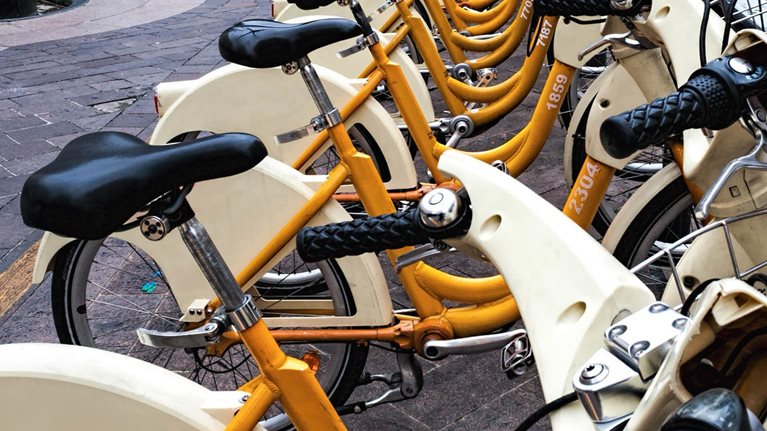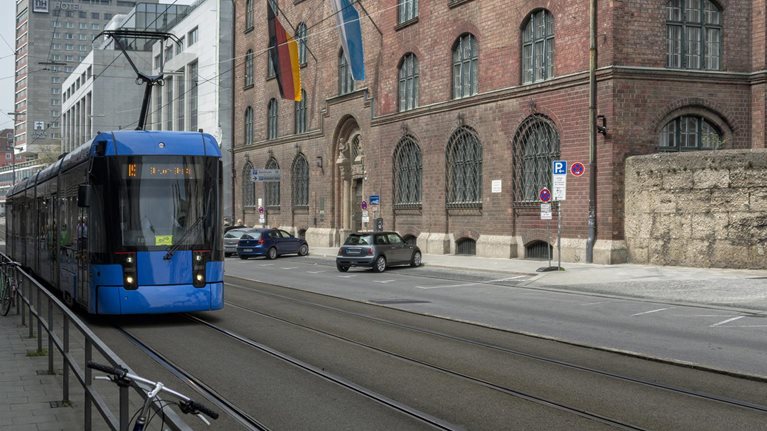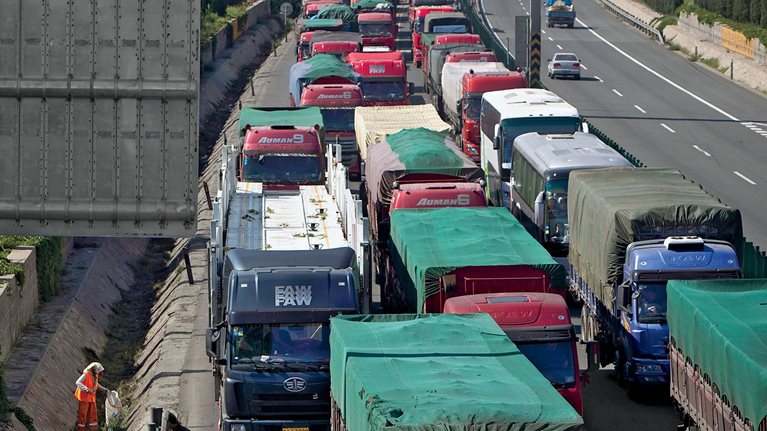To view a city from above is to observe a world in motion. Trains carry people to and from work; taxis circulate in abstract patterns; trucks deliver goods and carry away garbage; pedestrians hustle down city blocks; cyclists zip through traffic. Mobility is the lifeblood of our cities and essential for urban life.
Yet, our desire for mobility has consequences: cities can be noisy, congested, and prone to smog. Far too many urban residents spend hours stuck in traffic; no one can escape airborne pollution. Mobility is also a critical economic factor, both in its own right and as the means of providing the goods and services that are the foundation of economic life. Finally, mobility matters to people, whether this is getting to work or school with ease, visiting friends and relatives, or simply exploring one’s surroundings. In relatively few places, however, does the reality of what is available match the public’s aspirations for safe, clean, reliable, and affordable ways to get from A to B—and back again.
We believe, however, that the way people move around the urban environment is primed for dramatic change. Already, new business models, as illustrated by organizations such as Uber and Didi Chuxing, are changing traditional mobility patterns. Technological innovations in the form of electrification, connectivity, and autonomy are on the horizon. Increasing urbanization and the growth of “megacities” with more than ten million people provide the conditions for change.
What, then, will be the future of urban mobility? A new report, An integrated perspective on the future of mobility, a collaboration between Bloomberg New Energy Finance and McKinsey, seeks to answer that question. To do so, it explores how a number of existing social, economic, and technological trends will work together to disrupt mobility at the local level.
The result is a radically different future based around three models of advanced urban mobility that are achievable by 2030. Inevitably, individual cities will make different decisions, based on specific local conditions, and go in different directions—and, globally, mobility systems in 2030 will on average look very much like they do today.
Yet there is a cluster of some 50 urban areas that could lead the way toward one of the three advanced-mobility models. These areas have the potential to demonstrate the profound effects of mobility innovation on everything from power systems to the use of public space, while simultaneously introducing a new city dynamism.
The mobility systems of the future are likely to be very different from what exists in most of the world today. The individual traveler is at the heart of this evolution, so consumers will need to be open to adopting new technologies and services. However, both the public and private sectors will have roles to play in paving the way.
The value of an integrated perspective
Numerous trends, ranging from energy decentralization to the Internet of Things, are likely to come together to create drastic changes in mobility systems over the next 10 to 15 years.
Predicting the future is perilous. In this case, however, two factors point us in this direction. First, several key mobility trends—electrification, shared mobility, and autonomy—are poised to take off. The costs of a lithium-ion battery pack fell 65 percent from 2010 to 2015, and they are expected to drop below $100 per kilowatt-hour over the next decade. Car-sharing and ride-hailing services are already at work in hundreds of cities around the world, enabled by smartphones and backed by substantial venture capital. An array of established automotive and technology companies, as well as intriguing start-ups like nuTonomy and Zoox, are testing self-driving capabilities, with the aim of providing door-to-door travel, with no human intervention required.
Second, and just as important, trends in related areas reinforce one another. Urbanization is expected to increase average city density by 30 percent over the next 15 years, stretching existing systems as demand rises. Urban planners and residents are putting livability and sustainability higher on their agendas. Increased connectivity is opening the door to multiple shared-mobility options and could also help to smooth traffic flows.
Would you like to learn more about our Sustainability & Resource Productivity practice?
Looked at in isolation, each trend is significant. Their combined impact, however, will prove to be truly powerful. For example, more shared mobility could boost electric-vehicle (EV) sales because shared vehicles are used more intensively, improving the economics of ownership. In turn, higher EV production could accelerate innovation and reduce the cost of batteries. That opens up applications in adjacent systems, such as distributed storage. And the plummeting cost of distributed power generation could improve the greenhouse-gas abatement potential of EVs, because they would get more of their juice from low-carbon sources. In these and other cases, there is a powerful dynamic of mutual reinforcement at work. It’s not just one oar in the water—but lots of them, all pulling in the same direction.
The future of mobility in three models
Today, a small number of cities, such as Amsterdam, Singapore, and Stockholm, are singled out as having effective mobility. With varying degrees of emphasis, they have efficient public transit, encourage cycling and walking, and have managed to limit congestion and pollution. By 2030, we expect a number of additional systems to be at the leading edge of the next phase of advanced mobility.
In broad terms, the best will combine shared mobility, autonomy, and electrification with integrated energy systems, public transport, and infrastructure. In specific terms, cities will navigate these possibilities differently. Local conditions—such as population density, wealth, the state of road and public-transit infrastructure, pollution and congestion levels, and local governance capabilities—will determine what changes occur, and how quickly.
For the near future in cities leading the advance, we envision three mobility trajectories, with trends such as sharing, autonomous driving, and electrification all moving forward at a different pace. Each is suited to a specific type of metropolitan area, whether it be a dense developed city, a suburban sprawl, or an emerging metropolis.
Clean and Shared. Delhi, Mexico City, and Mumbai are examples of densely populated metropolitan areas in developing countries. They are all experiencing rapid urbanization, and they all suffer from congestion and poor air quality. For cities like these, the widespread use of self-driving cars may not be an option in the short or medium term, because of poor infrastructure, interference from pedestrians, a variety of vehicles on the road, and a lack of clear adherence to traffic regulations. The approach most likely to apply is a shift to cleaner transport, in the form of EVs, while also limiting private car ownership, optimizing shared mobility, and expanding public transit. In conjunction with some connectivity and autonomy, traffic flows and safety could be enhanced. According to our research, if relevant Asian cities move toward this model, by 2030 shared vehicles could account for almost half of passenger miles due to a combination of greater utilization and more passengers per trip.
Private Autonomy. There are many cities around the world where development and commuting patterns have increased sprawl significantly. In such cities, having a car is all but essential. That will likely remain the case for the foreseeable future. However, there are genuine costs to this way of life; congestion in Los Angeles costs the city an estimated $23 billion per year.1
To do better, we envision consumers in these cities embracing new vehicle technologies, such as self-driving and electric vehicles. Dedicated road space, for example, could be allocated to self-driving vehicles. Connectivity could make it easier to implement demand-driven congestion charges, which could increase road capacity while limiting new construction. Car sharing and ride hailing could emerge as complementary options but would not replace the private car on a large scale.
There is a possible drawback to this scenario: with lower marginal costs to travel an extra mile in an EV, and without requiring a driver’s attention thanks to autonomy, the demand for mobility could increase and thus add to congestion. Passenger miles traveled could grow 25 percent by 2030, with the majority attributable to additional autonomous travel in private vehicles.

Rolling along: Bicycles, mobility, and the future of cities
Seamless Mobility. This is the most radical departure from today’s reality. In the near term, it is likeliest to emerge in densely populated, high-income cities such as Chicago, Hong Kong, London, and Singapore.
In this system, mobility is predominantly door to door and on demand. Travelers have many clean, cheap, and flexible ways to get around, and the boundaries among private, shared, and public transport are blurred. Mobility is delivered through a combination of self-driving, shared vehicles, with high-quality public transit as the backbone. EVs become far more common, spurred by economics, consumer interest, incentives, and the creation of low-emission zones. And all this is enabled through the use of smart software platforms that manage multimodal traffic flows and deliver mobility as a service.
In a seamless-mobility system, people would potentially travel more—likely by 20 to 50 percent—because it is cheap and easy. However, the number of cars would likely remain the same or decline, due to the high level of sharing and significantly higher utilization. EVs could account for as many as two-thirds of vehicles on the road, while those capable of self-driving may exceed 40 percent.
Knock-on effects
Combined, these three models could apply to around 50 urban areas globally—representing some 500 million people—but the majority of cities are expected to develop more incrementally. Cities are most prone to accelerated uptake based on a ranking of metrics, including income, population, government effectiveness, level of public-transit development, congestion, and pollution. Each model can deliver significant benefits, such as saving time, reducing congestion, and improving air quality. We quantified the possible cumulative societal benefits of each model until 2030: $2,800 per person for Clean and Shared, mostly in the form of improved safety; $3,300 for Private Autonomy (boosting 2030 GDP by 0.9 percent); and $7,400 per person for Seamless Mobility (boosting 2030 GDP by 3.9 percent).
To take full advantage of these benefits and avoid the pitfalls, the public and private sectors would need to work together, while city officials would need to be willing to reconsider how they conduct their own business. For example, sharing and autonomy could cannibalize public-transport systems, and cities may consider whether it makes sense to partially shift ownership to private shared-mobility providers. Governments may also want to rewrite fuel and power taxation and to use the opportunity of connectivity to revisit how infrastructure is priced.
These new mobility models will also require a number of sectors to do some hard thinking in order to find new opportunities—and to avoid some major risks. In the power sector, for example, EVs could represent 3 percent of electricity demand globally, and nearly 4 percent in Europe, by 2030. Differentiated time-of-use rates and investments in charging infrastructure could help utilities to mitigate negative grid effects from EV charging. EVs could also play a role in reducing curtailment as solar-photovoltaic and offshore-wind generation increase.
The automotive sector faces a future that could be fundamentally different from its past and may need to consider moving from using a pure product-ownership model toward providing a range of transportation services. EVs, of course, are a direct threat to the internal-combustion engine. Gasoline retailers should be thinking through how to further monetize current assets and how to capture future value through new propositions around convenience retail, the connected car, fleet services, and electric charging. For tech companies, the three mobility models offer a world of opportunity. As the use of connectivity and autonomy increases, so, too, does the need for sensors and software. The data generated could be highly valuable in and of itself.
Moving into the future
In cities from Tokyo to Vancouver, the reality of changing mobility is already apparent. More shifts are coming. These changes will allow people to travel more efficiently, more cheaply, more often, and in different ways. But the future is not set, and there is a strong role for the public and private sectors to help avoid pitfalls associated with increased congestion, air-quality concerns, and other potential negative outcomes.
To best capture the benefits, the public and private sector—at a local and global level—need to prepare for the future, not wait for it. Governments may want to anticipate these new mobility models by crafting regulations consistent with consumer-friendly technological developments that also promote larger public goals, such as clean air and reduced congestion. They need to think ahead, with regard to both replacing the possible loss of fuel-tax revenue and reviewing their connection with the private sector. Strong partnerships that make it easy to blend public transit and private mobility will likely produce the best solutions.
Why does this matter? Because getting mobility right could be a significant competitive advantage for cities. This shift can help clear the air of pollution and reduce traffic deaths. It is an opportunity to improve the quality of life—day in, day out—for billions of people.
Download the full report on which this article is based, An integrated perspective on the future of mobility (PDF-19,792KB).


